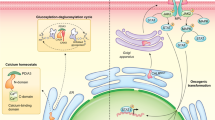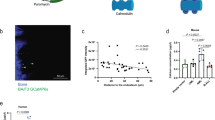Abstract
Cell proliferation is accompanied with changing levels of intracellular caimodulin (CAM) and its activation. Prior data from synchronized cell population could not actually stand for various CaM levels in different phases of cell cycle. Here, based upon quantitative measurement of fluorescence in individual cells, a method was developed to investigate intracellular total CaM and Ca2+-activated CaM contents. Intensity of CaM immunoflurescence gave total CaM level, and Ca2+-activated CaM was measured by fluorescence intensity of CaM antagonist trifluoperazine (TFP). In mouse erythroleukemia (MEL) cells, total CaM level increased from G1 through S to G2M, reaching a maximum of 2-fold increase, then reduced to half amount after cell division. Meanwhile, Ca2+- activated CaM also in creased through the cell cycle(G1, S, G2M). Increasing observed in G1 meant that the entry of ceils from G1 into S phase may require CaM accumulation, and, equally or even more important, Ca2+-dependent activation of CaM. Ca2+- activated CaM decreased after cell division. The results suggested that CaM gene expression and Ca2+-modulated CaM activation act synergistically to accomplish the cell cycle progression.
Similar content being viewed by others
Introduction
Calmodulin (CAM) is regarded as an intracellular modulator, mediating calcium triggered cascade events in signal transduction. Intracellular CaM content varies with cell cycle progression. It was reported that CaM gene expression is cell cycle dependent. CaM level changes in reentry of quiescent cells into the cell cycle, which is preceded by changes in CaM mRNA levels1. CaM concentration indifferent cell cycle phase were measured using synchronized cell populations which were, in most cases, not pure cultures, and synchronization may influence natural growth of cells. Measurement of CaM content based upon individual cells in normal culture can properly indicate actual CaM distribution in cell cycle. As activation of CaM depends on Ca2+ binding, total intracellular CaM consists of two forms, inactivated CaM without Ca2+ binding, and Ca2+-bound activated CaM. Conventionally, total CaM can be measured by phosphodiesterase (PDE) assay 2, radioimmunoassay (RIA)3, immunofluorescence (IF)4 and mRNA analysis1.
Based on fluorescence intensity, a method has been developed to measure total CaM and Ca2+-activated CaM in individual cells at different phases of cell cycle. FITC-conjugated anti-calmodulin antibodies, TFP and propidium iodide (PI) were used to stain total CaM, Ca2+-activated CaM and DNA, respectively. We found that in MEL cells, total CaM content increase with the progression of cell cycle, and the maximum value was observed in G2M. The cell cycle phase was identified by DNA content. With this method we could investigate the role of total CaM and Ca2+- activated CaM in the cell cycle of MEL cells.
Materials and Methods
Cell Cultures
MEL cells were maintained in suspension cultures at 37°C in humidified atmosphere of 5% CO2 in Dulbecco's modified Eagle's (DMEM), supplemented with 10% fetal calf serum. Cells were kept at densities between 1×104 and 1×106 cells per ml.
Staining with Anti-CaM Antibodies
Anti-CaM antibodies were used to stain MEL cells by indirect immunofluorescence. Exponentially growing cells were thrown to the glass coverslips with cytospin. The cells on coverslips were fixed in 70%0 cold ethanol for 24 hr. Coverslips were incubated with 30 μl of first antibody solution at 1 : 2.5 dilution (sheep anti-CaM,Polysciences, Inc.) for 45 min. The coverslips were washed three times for 15 min in PBS, then incubated for 45 min with the second antibody(rabbit anti-sheep IgG, Polysciences, Inc.) which is conjugated with FITC. The preparation was washed again with PBS and rinsed in distilled water.
Staining with Trifluoperazine (TFP)*
Coverslips with fixed cells were mounted on a slide containing a drop of 1×10-4 M TFP in PBS. The slide were then incubated (set aside) for 10 min. and UV-irradiated for 15 min., The coverslips were rinsed in PBS5, 6.
Staining with Propidium Iodide (PI)
After separate staining with anti-CaM antibody and TFP, the coverslips were stained with 5 μg/ml (PI) for 15 rain. as DNA indicator, washed in PBS, removed excess water by blotting, and mounted in a drop of glycerol/PBS (9: 1, pH 8.5) on a slide.
Quantitative Measurements Fluorescence spectra resolution
Fluorescent spectra of cell stained with single dye (FITC, TFP, PI) were first obtained by exciting FITC with blue light (450–490nm), TFP and PI with violet light (400–450nm).
Fluorescence analysis
Fluorescence emission spectra and fluorescence intensity were measured with a Leitz Mierophotometer. In double-stained cells, (e.g. stained with anti-CaM-FITC/PI), excitation light for FITC was blue and for PI was violet as described above. Relative fluorescence intensity measurement in individual cells was similar to spectra measurement, but a S525 band-pass filter was needed for FITC and TFP, 610 nm long-pass filter for PI.
Results and discussion
Considering probable mutual interference of two fluorescence waves, spectra properties of any single dye must be analyzed prior to the coordinated measurement of two-colors. Emission spectra of FITC and TFP were distinguished significantly from that of the PI (Fig. 1). The partial overlap of the spectra in 570–600 nm region, which may cause devotion of one fluorescence to another, can be eliminated by means of additional filters, $525 band-pass filter and 610 nm long-pass filter. In this way, FITC/PI or TFP/PI fluorescence intensity could be measured simultaneously.
When the specimens were subjected to the microphotometer analysis, histogram of PI fluorescence intensity had characteristics of spontaneous pro!iferatingcell population. DNA content varied between 2C and 4C. Cells in G1, S, G2& M, phases were possessed of 2C, 2C-4C and 4C DNA content respectively (Fig. 2B, 3B). Green fluorescence intensity of FITC made a 1-2 fold alteration (Fig. 2C), and blue fluorescence intensity of TFP had a 1-3 fold variation (Fig. 3C). When the fluorescence intensity of FITC and/or TFP were combined with that of PI, it gave distribution of anti-CaM antibodies and/or CaM antagonist TFP in cell cycle of MEL (Figs. 2A, 3A). FITC intensity was the lowest in early G1 phase, increased during the whole cell cycle, and arrived its peak in G2M. TFP intensity increased from the lowest level in early G1 and rose rapidly to a high level in late G1. Higher level than in late G1 was only found in S and G2M phases, and the highest one appeared in G2M.
We might as well use the words “tolal CAM” and “Ca2+-activated CaM”to express CaM content measured in IF method and in other method founded on CaM activity respectively. CaM acts as a mediator in intracellular Ca2+ regulation. The role of CaM relies on Ca2+ activation. Anti-CaM antibodies were polyclonal and reacted with both inactivated and Ca2+- activated CaM. In our work, FITC intensity indicated total CAM, TFP is known as an antagonist of CaM and therefore inhibits CaM-dependent process. Although TFP can bind wide range of Ca2+-dependent proteins, its binding to CaM in high affinity sites is found only in the presence of Ca2+-CaM. It is thought that the binding of Ca2+ to CaM exposes a hydrophobic region that can interact with the CaM-binding protein or with the CaM antagonist7. Thus, CaM bound TFP should be the Ca2+-activated CaM. The binding is Ca2+-dependent and becomes irreversible after UV irradiation and light oxidation 8. In our experimental conditions, intensity of TFP fluorescence may have quantitative rely on Ca2+- activated CaM. TFP specificity has been confirmed in some morphological studies in tip-growing plant cellsl5and participation of immunoglobulin capping6.
Now, the fluorescence intensity of FITC represents total CaM, and that of TFP represents Ca2+-activated CaM. As a result, both total CaM and Ca2+-activated CaM increased during cell cycle of MEL cells, indicating that CaM accumulation began at G1 and reached at a maximum value in G2M. On the other hand, a proportion of CaM was activated by Ca2+-binding, and thereby triggered CaM-dependent processes. An interesting finding was that the late G1/early 8 phase cells held not significant difference in FITC fluorescence intensity, but the disparity was obviously found in TFP intensity of late G1/early S phase cells. As shown in Fig. 2A, G1 and S phase largely piled up in FITC coordinate. In Fig. 3A, there was nearly no overlap in TFP coordinate. This meant that total CaM could increase in G1, but high level was not required for the entry of G1 cells into S phase. While TFP labelled Ca2+-activated CaM must be raised to a high level, probably a threshold of about 84 in TFP relative intensity (Fig. 3A), to trigger the entry of G1 cells into S phase.
CaM content could be regulated by CaM gene expression (transcription and translation etc.). So the change of CaM content was relatively slow. But this change of CaM content has important role in the supply of Ca2+ mediator and Ca2+buffering7. Ca2+-activation of CaM was regulated by intracellular Ca2+ movement which was a quick response to intracellular signals or extracellular signals and/or stimuli. Ca2+-acti vated CaM then mediated a series of events which were supposed to be the key steps of cells entering S phase.This could be an explanation of the free Ca2+ surge in late G1/early S phase9,and Ca2+ antagonists or CaM antagcnists inhibited C3H/10T/1/2 mouse fibroblast cells from G1 entering into S phase (data not published). When we look at the proliferating process, total cell CaM reduced into half after cell division, Ca2+- activated CaM also reduced in quantity, or decreased its activity. The distribution of total CaM and Ca2+-activated CaM in cell cycle demonstrated that CaM accumulation was necessary for cell cycle progression, and the role of CaM in triggering the entry of Gj cells into S phase was dependent on Ca2+ activation.
References
Chafouleas JG et al. Changes in calmodulin and its mRNA accompany reentry of quiescent (Go) cells into the cell cycle. Cell 1984: 36: 73–78.
Wallace RW et al. Assay of calmodulin by Ca2+-dependent phosphodiesterase. In: Means AR, Omalley BW, eds. “Methods in Enzymologoy”. New York, London: Academic Press, 1983: 102 : 39–46.
Barbara E et al. Enzyme-liked lmmunoabsorbent Assay (ELISA) and Radioimmunoassay (RIA) for vitamin D dependent 29,000 Dalton calcium-binding protein. In: MeansAR, O'Malley BW, eds. “Methods in Enzymology”. New York, London: Academic Press, 1983: 102: 291–296.
Welsh MJ . Localization of calmodulin and calmodulin acceptor sites by fluorescence methods. In: Means AR, O'Malley BW. eds. “Methods in Enzymology” New York, London: Academic Press, 1983: 102:110–135.
Hauper I, et al. Calmodulin in tip-growing plant cells visualized by fluorescing calmodulin binding phenothiazines. Planta 1984; 162: 33–38.
Nelson GA, et al. Participation of calmodulin in immunoglobulin capping. J Cell Bid 1982 ; 95 : 771–776.
Cachia PJ et al. Structural studies on calmodulin & troponin C: phenothiazine, peptide, & protein interactions with calcium induced helices. In: Hidake H, Hartshorne DJ, eds. “Calmodulin antagonists & cellular physiology” New York, London: Academic Press, 1985; 63–88.
Prozialeck WC, Cimino M, Weiss B . Photoaffinity labeling of calmodulin by phenothiazine antipsychotics. Mol pharmacol 1981; 19: 258–264.
Whitfield JF, et al. The roles of calcium & cyclic AMP in cell proliferation. Ann NY Acad Sci 1980; 339: 216–240.
Acknowledgements
Project supported by National Natural Science Foundation
* TFP is a gift from Shanghai Huanghe Drug Manufactory
Author information
Authors and Affiliations
Rights and permissions
About this article
Cite this article
You, J., Li, S., Wang, D. et al. The distribution of calmodulin and Ca2+-activated calmodulin in cell cycle of mouse erythroleukemia cells. Cell Res 1, 89–94 (1990). https://doi.org/10.1038/cr.1990.9
Received:
Accepted:
Issue Date:
DOI: https://doi.org/10.1038/cr.1990.9
Keywords
This article is cited by
-
Distribution and role of calmodulin in tip growing hyphae of Saprolegnia ferax
Cell Research (1995)
-
Intracellular levels of calmodulin are increased in transformed cells
Cell Research (1992)






